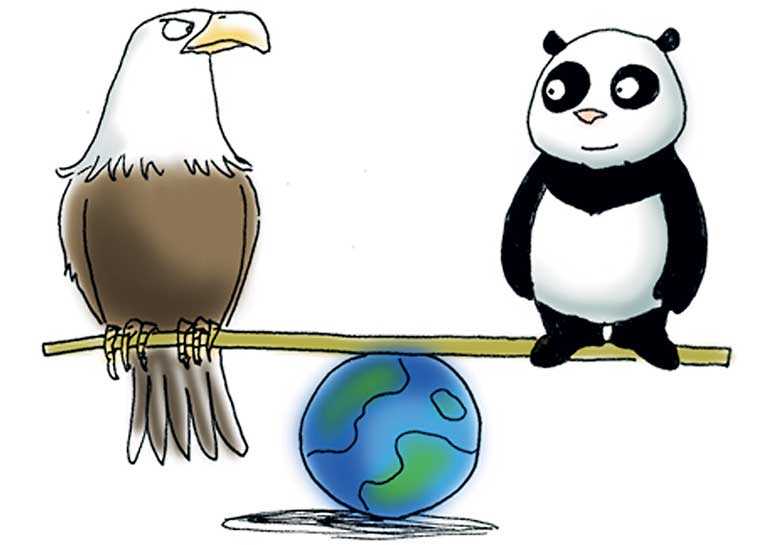Saturday Dec 06, 2025
Saturday Dec 06, 2025
Tuesday, 5 June 2018 00:00 - - {{hitsCtrl.values.hits}}

We are in the midst of a technological revolution that will fundamentally alter the way we live, work and trade. It seems in its scale, scope, and complexity, the transformation will be unlike anything humankind has experienced before.
We do not yet properly know just how it will unfold over the coming decade and beyond. But one thing is clear: All stakeholders around the world, from the public and private sectors to academia and civil society will have an impact as new social order is being created in front of our own eyes. This we call the 4th Industrial Revolution or the NOW for domination of the world through trade.
The 1st Industrial Revolution used water and steam power to mechanise production. The second used electric power to create mass production. The third used electronics and information technology to automate production. Now a 4th Industrial Revolution is building on the third, the digital revolution that has been occurring since the late last century which is the one that is transforming the way we work in short cycles. It is characterised by a fusion of technologies that is blurring the lines between the physical, digital, and biological spheres.
There are three reasons why today’s transformations represent not merely a prolongation of the 3rd Industrial Revolution but rather the arrival of a fourth and distinct one: velocity, scope, and systems impact from a household to a business entity and government. The speed of current breakthroughs has no historical precedent.
When compared with previous Industrial Revolutions, the fourth is evolving at an exponential pace rather than a linear pace. Moreover, it is disrupting almost every industry in every country. And the breadth and depth of these changes herald the transformation of entire systems of production, management, consumerism and governance and most importantly the impact on supply, value chains and education.
As I write this article, the world without knowing has got into a first stage of cold war on trade. It is clearly reversing a trend of trade liberalisation after decades of the end of World War II which led to the creation of the WTO by 1995. However, the very establishment and its core principles/values are being challenged with the new order of global economics and politics.
The World Trade Organization (WTO) is being the only international organisation dealing with the rules of trade between nations are now finding that the bigger powers of the trading world are slowly moving towards unilateral actions threating the establishment itself. One cannot rule out the fact that these reactions are the consequences of the shift in production bases and the employment factors of the developed world due to the technological shifts that the 4th Industrial Revolution has created within a very short period of three to four decades.
Population shift of markets and conflicts
As the population surpasses 7.5 billion and moves towards nine billion, many new markets in Asia, Africa and Latin America are emerging. With reasonable economic growth these economies will lead to strong consumer markets and geo political balances will be affected because of macro level market shifts. The immediate and obvious reaction for this has been protectionism led by the United States and some members of the European Union.
The way forward is certainly not protectionism. Whilst we have advance in technology we have not yet even got close to finding the solutions for the new era of trade and connectivity and that itself is a danger for greater conflict.
This shift in economic power is leading to new areas of disagreement and conflict. World War I was fought mainly for power in Europe and control of territory of the empires which expanded to Africa’s and the Middle East. World War II was fought between two groups of countries. On one side were the axis powers, including Germany, Italy and Japan. On the other side were the Allies. They included Britain, France, Australia, Canada, New Zealand, India, the Soviet Union, China and the United States of America.
As the 21st century dawned with the emergence of China as a power, a stubborn but a real fact is that we are moving towards the ocean resources including disputes on oceans and transport corridors for connectivity. The South China Sea, the Indian Ocean, Arctic and Antarctic seas and corridors are now very much on discussion as nations feel that the next level of control of trade is through major transport networks that control the oceans and major land corridors.
BRI and trade and geopolitics
Among many discussions, the Belt & Road Initiative (BRI) is probably the biggest and the most-talked-of projects around the world. Almost 90 countries are now directly or indirectly involved of this mega project of China, running into trillions of dollars investments, which seems to create a new paradigm shift in transport and logistics.
Some sceptics feel this is more of talk than reality. Others feel it is an invasion and a colonisation of China which is a repetition of a 5,000-year-old world order history, where China was supposedly the dominant force. While China sees it as a facilitation for countries to emerge has winner of greater trade, this new phenomenon has certainly raised eyebrows of many global powers as they fail to understand the actual deliveries and repercussions that would unfold the world economy through BRI. Within a short span of five years, the BRI has indeed become reality in many parts of Asia, Africa and Europe.
World trade is fundamentally based on economic theories such as efficiencies, resources and technology. However, the 4th Industrial Revolution has changed the dynamics to speed and knowhow as two new instruments to compete and win the race. As new markets emerge, we all know that technology has created speed in terms of connecting products with consumers, shifting market behaviour and consumer patterns. Both manufacturing and retailing has new challenges as development of new consumer behaviour requires new methods of delivery and market control. As it is said, it is not the big who wins, but speed is the greater tool for market access today as we are living in times of innovation on the digital platform.
In terms of physical goods and merchandising, even today ocean corridors provide nearly 90% of global trade. However, the high value merchandise seems to be connecting through fast land corridors such as railway and air. Therefore, the BRI project of China, is focused on these transport networks which are connecting many countries which are bridging old and new markets closer. Offshoring models are being challenged.
As connectivity is getting better, it has also disrupted global supply chains and new logistics solutions are emerging to cope up with this demand.
(Research for this article has been sought from multiple sources from the internet.)
(The writer is the CEO of Shippers’ Academy Colombo, an economics graduate from the Connecticut State University USA, and immediate past secretary general of the Asian Shippers’ Council.)
This phenomenon is the very reason that disputes on ocean corridors are seen emerging which is creating geo-political uncertainties/rifts which has led to the current issues between USA and china and rest of the world as well. Also, new developments in free trade and trade agreements/blocks are also part and parcel of these tremors of geopolitics. The Brexit and the US withdrawal from the biggest trade agreement Trans-Pacific Partnership agreement (TPP) last year, was probably a result of unhappiness of the market access as seen by the United States.
Challenges to survive
Developing and emerging countries too need to change rapidly in terms of creating further value to compete for trade and services. In terms of merchandise trading, the Bali Agreement of Trade Facilitation in 2013 is a major tool that will help smaller economies to improve productivity and speed if they are to be in the global supply chain. Such reforms are a key element to attract foreign direct investment to a country.
In addition, smaller countries need to connect to major markets through new trade agreements that can help market access directly or indirectly, for both products and services. Another crucial factor for these developing countries is education system reforms that would upgrade university systems to the new world order to train on technology-based industry.
At the same time technology which probably is freely available today due tools such as the internet and movement of people, it is important to understand that the labour forces must be reformed to deliver through understanding these technologies.
In terms of physical processes we call it re-engineering the work place. But in terms of human resources, small countries must go beyond re-engineering of machinery but re-skilling, up-skilling and adapting new skills for the workers is a non-negotiable part if they want to be a part of the 4th Industrial Revolution. As the way things are unfolding now, changes don’t take years to happen but few weeks in the world market.
The 4th Industrial Revolution can be defined as the “smart and the intelligent era” of human evolution that cannot be described or forecasted easily even by the best economists. Being and thinking ahead of the NWO curve is the only advice I can think as an economist. On the other hand, if this transformation is not managed with care it can disrupt not only what we like but the very same world order that we would want for peace and harmony and avoid greater confrontation.